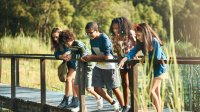Bringing Climate Change Into the Elementary Classroom
Make this big issue personal for young students by showing them how they can work toward solutions using community science.
Your content has been saved!
Go to My Saved Content.Climate change is a complicated topic, especially for young students. I used to steer clear of the subject in my classes, terrified of traumatizing my young learners. Surely my own climate anxiety would make things worse—I’m not a climate scientist, and this wasn’t part of my teacher training. Besides, climate change isn’t in my state curriculum, and I thought my students’ families would get upset with me for teaching it.
Then I heard the whispers in my classroom: “Humans are hurting the planet.” “The world is ending.” “We mess up everything we touch.” I realized children were already being influenced by climate change—through direct experiences or the media—and they were starting off with a damaged foundation. Now I feel a responsibility to build climate hope and agency in my young students, and my most trusted tool is community science.
Community Science
Community science allows everyone to participate in scientific research. Projects are designed to crowdsource information, collecting data from volunteers across large areas and over long timescales—something a single researcher could never do on their own. As our climate changes, shifts in annual weather patterns change the timing of life-cycle patterns on a local scale. Phenology is the study of seasonal life-cycle patterns, and we see these changes around us all the time: flowers blooming, birds building nests, and insects that we didn’t see the week before. Each observation we make is a snapshot of a life-cycle event happening in a certain place at a certain time, and when we look at these snapshots year over year, we can see phenological change firsthand.
So why use community science as a tool to address climate change in the classroom? In short, teachers can help meet the need for community-sourced data while building students’ science skills, modeling community engagement, and empowering the next generation of scientists.
Building Science Skills
Community science is real science. Each time I tell my students that their observations could be included in ongoing scientific research, their eyes light up. In practice, it isn’t that different from what we usually do in science class. By recording blossoms, bird sightings, or autumn leaves, students practice essential science skills like making observations, collecting data, and identifying patterns. But when students are able to share their observations with scientists and compare their data with past records, it becomes so much more than going through the motions of the scientific method.
Students build climate literacy and share essential data on the effects of climate change on their local environments. Existing community science projects like Nature’s Notebook, I See Change, Budburst, and Seek by iNaturalist make it easy for participants to share phenological observations with scientists and to look through past data to identify local patterns over time. If technology is a barrier, teachers can build their own community science projects on a smaller scale, through either adding to a class phenology binder each year or simply practicing nature journaling—which is how the “father of phenology,” Aldo Leopold, got his start.
Building Community
Community science is a mode of collective action, which helps classrooms to engage in climate solutions without feeling personally responsible for saving the planet. Through the lens of community science, students can tackle this heavy topic as a team, building connections with their local habitats and finding meaning in the patterns they observe. This includes my role as their teacher: Instead of being the climate authority in our classroom, I support my students in their own inquiries and facilitate information sharing among the team.
Engaging in solutions socially also helps students understand collective responsibility and paves the way for future civic engagement. Depending on how they’re shared, student observations can be used directly in conservation research, management of natural resources, and policy changes. Modeling collective action and community support shows students that they aren’t alone and that we can work together to protect our Earth.
Building Self-Efficacy
Young people feel helpless, worried, and pessimistic about the future of our planet, and they may feel that there’s nothing they can do to help. When students are aware that their personal observations are helping scientists to understand the impacts of climate change, they’re able to build agency in the issue. Community science is now my go-to when talking about challenging topics like climate change, and it’s helped me turn that negative classroom narrative on its head. My students are hopeful about the future. Each time they submit their data, I can see on their faces that they feel empowered, included, and that their input means something.
Actively participating in the process of science also breaks down barriers to science as a whole, especially when students can engage in a way that is meaningful to them. They went from loudly proclaiming their dislike for science to asking my permission to do online community science projects on their breaks and even participating in other community science projects on their own time.
It turns out that my students’ families were glad that I was teaching climate science and they were interested in community science too. Our youngest students will be most affected by climate change, so we have a responsibility to build them up to face these challenges. Community science cuts the anxiety of teaching climate change for me and my students, and it is more enriching than I ever imagined. Try it for yourself.
